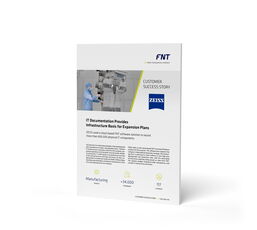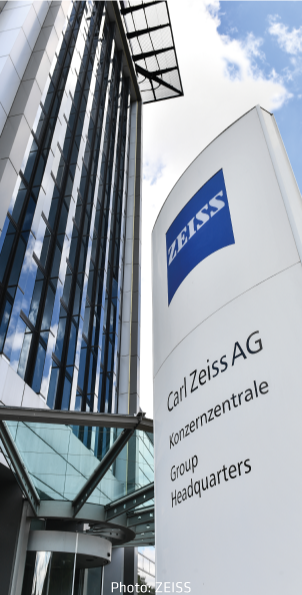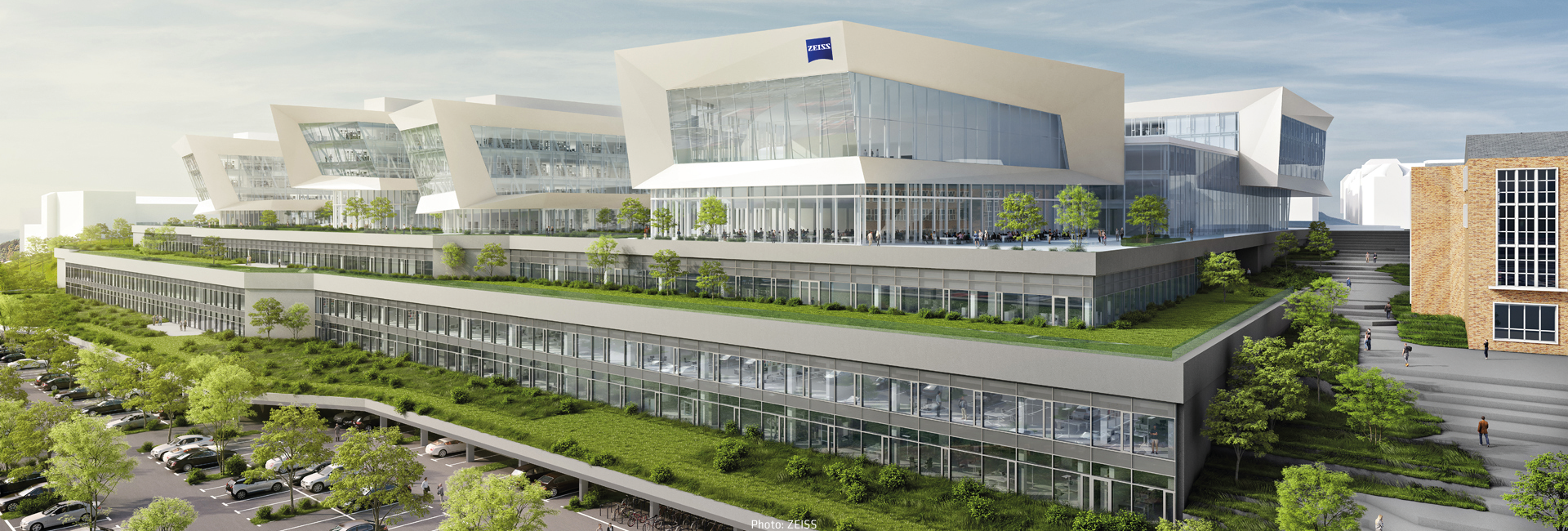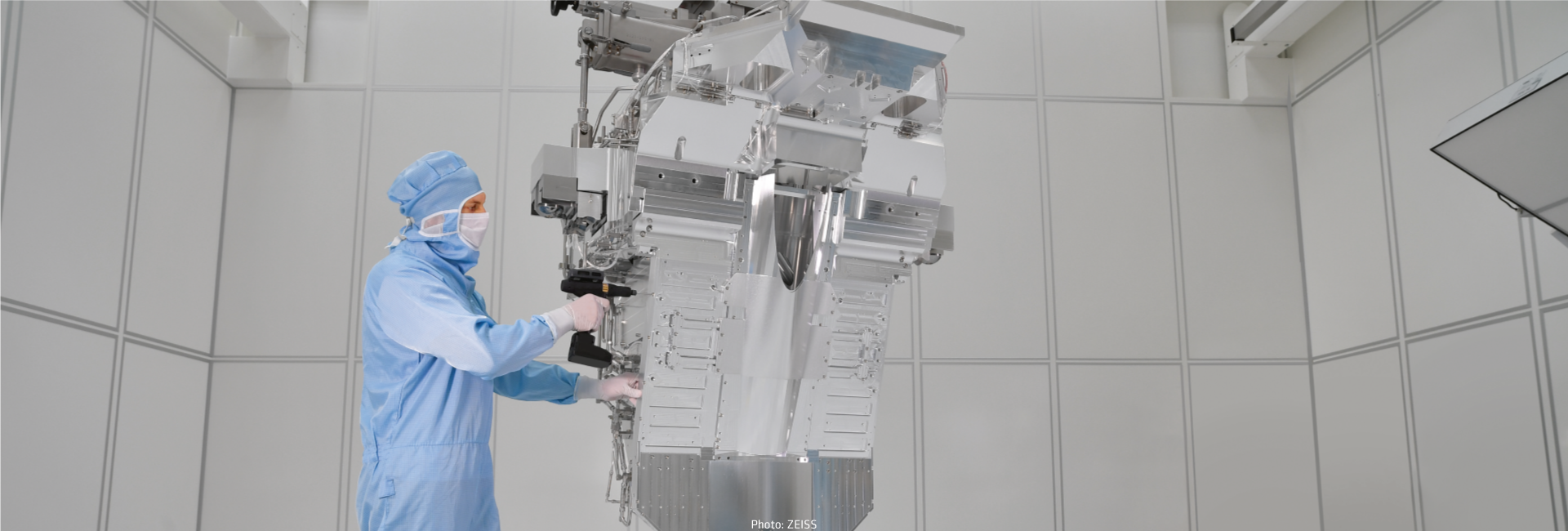
IT Documentation Provides Infrastructure Basis for Expansion Plans

Carl Zeiss AG is an international leader in the development and manufacture of optics and optoelectronics. Flawless IT infrastructure is business-critical for the company; production operations in its factories must be totally reliable. To achieve this, IT staff require a comprehensive overview of the infrastructure at all times and across all sites, enabling them to locate and rectify any faults without delay. Seamless documentation of physical components is thus of crucial importance for the company.
ZEISS relies on the cloud-based FNT Command Platform solution for this purpose. The software also supports the company’s international expansion strategy: the technology firm is planning to invest millions in new high-tech development and production sites, with the associated infrastructure planning being based on data from FNT. The solution enables enterprise-wide transparency and smooth IT and business processes.
ZEISS used a cloud-based FNT software solution to record more than 600,000 physical IT components
Founded in Jena in 1846 by German optics pioneer Carl Zeiss, the company is now an international technology group with more than 200 sites around the world, including over 50 in Germany. With a portfolio aligned with future growth areas, such as digitalization, healthcare, and smart production, and backed by a strong brand, ZEISS is pursuing international expansion. The company has invested a billion euros in new buildings and infrastructure over the last ten years. A new ZEISS high-tech site in Jena, currently the company’s second largest location, is due to be completed by the end of 2024 and will provide 2,500 jobs. The facility is set to be one of the most modern factories anywhere in the world. ZEISS is also planning to invest many millions over the next five years at group headquarters in Oberkochen, Baden-Württemberg.
ZEISS – An optical pioneer with a long history
ZEISS is an internationally leading technology enterprise operating in the fields of optics and optoelectronics. Across its four segments (Semiconductor Manufacturing Technology, Industrial Quality & Research, Medical Technology, and Consumer Markets), the ZEISS Group generated annual revenue totaling EUR 6.3 billion in the last fiscal year (as of September 30, 2020).
For its customers, ZEISS develops, produces, and distributes highly innovative solutions for industrial metrology and quality assurance, microscopy solutions for the life sciences and materials research, and medical technology solutions for diagnostics and treatment in ophthalmology and microsurgery. The name ZEISS is also synonymous with the world’s leading lithography optics that are used by the chip industry to manufacture semiconductor components. There is global demand for trendsetting ZEISS brand products, such as eyeglass lenses, camera lenses, and binoculars.
With a portfolio aligned with future growth areas, such as digitalization, healthcare, and smart production, and a strong brand, ZEISS is shaping the future of technology and constantly advancing the world of optics and related fields with its solutions. The company’s significant, sustained investment in research and development provides the foundation for the success and continued expansion of ZEISS’ technology and market leadership. ZEISS is currently investing 12 percent of its revenue in research and development. This reflects a longstanding ZEISS tradition and is also an investment in the future.
With over 34,000 employees, ZEISS is active globally in almost 50 countries with around 30 production sites, 60 sales and service companies, and 27 research and development facilities. Founded in 1846 in Jena, the company is headquartered in Oberkochen, Germany. The Carl Zeiss Foundation, one of the largest foundations in Germany dedicated to the promotion of science, is the sole owner of the holding company, Carl Zeiss AG (as of March 31, 2021).


Restructuring Requires Accurate Knowledge of the IT Landscape
ZEISS began a worldwide restructuring of the group’s IT systems in 2012. “As part of this restructuring, we wanted to accurately map our existing IT landscape, including all the components and physical systems. A detailed inventory is a prerequisite for real-world planning of future locations,” explains Martin Dann, who is responsible for infrastructure projects at ZEISS. What’s more, reliable data on the existing infrastructure was essential for group-wide rollout of new technologies, such as 5G and the Internet of Things (IoT). To support its upcoming construction projects and ongoing development of existing plants, the technology company needed a detailed overview of its entire IT infrastructure across all 53 sites throughout Germany. The existing documentation was patchy and inconsistent. It was housed in multiple applications, ranging from Excel to PowerPoint to semi-professional documentation tools, in heterogenous formats.
Looking for a Cloud-Capable Solution
When the ZEISS IT team began systematically documenting all the physical systems, starting at group headquarters in Oberkochen, they quickly ran into obstacles.
“Because we had only limited human and specialist resources, we didn’t really make much progress. That’s why we decided to seek professional support,” says Martin Dann. The IT team looked at and evaluated a number of solutions as part of their market research. One particularly important requirement was that the documentation solution should be cloud-capable in order to fit in with the company’s cloud-first strategy. Since 2014, ZEISS has been gradually moving all applications into the cloud, unless the specific security requirements require on-premise operation.
"We opted for the standard FNT Command software, which met all of our key criteria,” comments the IT expert. “Alongside the ability to deploy the product in the cloud in the form of Software-as-a-Service, we found the breadth and depth of the solution compelling. The many different interfaces and sophisticated seven-layer data structure model are also major benefits,” adds Martin Dann. The model covers the seven layers from the physical level through to the business service and accommodates all documentation needs.
Iterative Development of the Documentation Process
ZEISS kicked off the documentation process by defining precise rules. This included clustering locations by size categories. Adopting an agile approach, staff then established the content and scope of documentation for each size category, laid down guidelines, and refined them in an iterative process. The new solution made it possible to close all documentation gaps and significantly improve data quality. ZEISS gradually cleaned up its existing documentation and imported it into FNT. Anything not previously captured was added manually. “With around 600,000 objects documented, this represents a major achievement by our team,” affirms Martin Dann.
Documenting the Physical
The scope of the documentation ranges from physical components, such as racks, cabling, switches, and routers, to network connections. The depth of the documentation depends on the size of the ZEISS location; the larger the location, the more detailed the documentation, because complexity increases with size.
By way of example, at the Oberkochen factory the huge production buildings are up to 1,600 square meters in size, spanning multiple levels and a number of separate technical areas, which poses quite a challenge. Because many devices, such as W-LAN access points and routers, are unable to handle harsh industrial manufacturing conditions, they are typically installed in dedicated rooms, with the result that accurate documentation is essential if they are to be found when needed. The company has divided the huge production facilities into a grid of three-meter-by-three-meter squares to make it possible to pinpoint the location of physical components. 45 locations totaling around 800,000 square meters of space have been documented. Overall, the ZEISS documentation contains some 600,000 components, including around 2,000 racks with approximately 14,000 patch panels and some 3,000 switches.

Precise Documentation Facilitates Incident Management
The FNT Command Platform delivers multiple benefits for ZEISS. There is now complete transparency into the entire IT infrastructure at the locations documented to date. “Having a detailed overview of our physical IT components enables us to identify the exact location of any incidents and faults and take effective countermeasures before more significant damage occurs,” says Martin Dann. The solution also supports efficient cooperation between the various parties involved. Browser access enables external partners, such as engineers, helpdesk operators, and other providers, to document their work in the FNT Command Platform. This creates a central, consistent database that can also be used to efficiently manage those partners. If switches need to be swapped out as part of a change of vendor, for example, reliable data allows the service provider to quickly locate the affected switches. This saves time, effort, and money.
The documentation solution also proved very helpful when managing the impact of the COVID-19 pandemic: at the beginning of lockdown, some 10,000 of the company’s 13,000 staff in Germany had to work from home. “Thanks to seamless documentation of our infrastructure, we were fully prepared for this exceptional situation. Within the space of just a few days and without any major issues, we were able to hook up home workspaces and rollout collaboration tools, such as Microsoft Teams,” explains the IT expert.
Successful Defense against Cyberattacks
The documentation solution has likewise provided support in crises of a different kind. In May 2017, amid a spate of cyberattacks by the WannaCry ransomware cryptoworm, the FNT Command Platform enabled ZEISS to precisely identify all at-risk clients via the location of their documented ports and isolate them from the network as a precaution. “If WannaCry had caused our factories to shut down for just ten minutes, that would have cost us around EUR 40,000. The FNT software provided effective protection, which made the investment worthwhile for that reason alone,” says Martin Dann.
Saving Cold, Hard Cash with Documentation
Dann also cites another situation: “As part of a construction project, a service provider needed an inventory of the existing physical infrastructure components in the location involved. They estimated that a five-figure budget would be required to do this. It cost me just a few mouse clicks to export exactly the inventory information they needed from our FNT system. I don’t often get to save several thousand euros quite so easily,” says the IT expert.
Looking Ahead: WAN Documentation and Automation
As the next step, ZEISS is planning to document its Wide Area Network (WAN) and automate the capturing of active components. The FNT solution already has interfaces that enable data to be imported into FNT without manual intervention and then passed to other systems. This not only simplifies the data capture process, it also reduces the general cost of documentation, cuts the error rate, and ensures that all systems hold up-to-date information at all times. “That would take us to the next evolutionary stage of our documentation and IT infrastructure management,” concludes Martin Dann.

Carl Zeiss AG is an international leader in the development and manufacture of optics and optoelectronics. Flawless IT infrastructure is business-critical for the company; production operations in its factories must be totally reliable. To achieve this, IT staff require a comprehensive overview of the infrastructure at all times and across all sites, enabling them to locate and rectify any faults without delay. Seamless documentation of physical components is thus of crucial importance for the company.
ZEISS relies on the cloud-based FNT Command Platform solution for this purpose. The software also supports the company’s international expansion strategy: the technology firm is planning to invest millions in new high-tech development and production sites, with the associated infrastructure planning being based on data from FNT. The solution enables enterprise-wide transparency and smooth IT and business processes.
About FNT
Powerful, reliable and flexible infrastructures are the basis for all digital business processes and applications, especially those supporting Smart Cities, Industry 4.0 or 5G. With FNT’s integrated software solutions, organizations can record, document and manage complex and heterogeneous IT, telecommunications and data center infrastructures from the physical level all the way up the stack to business services. FNT stores this information in a manufacturer independent, uniform data model. In this way, FNT provides the necessary transparency and tools to plan and manage the IT, data center and telecommunications landscape more easily to eliminate faults faster, to manage transformations and changes more efficiently and to automate delivery of new digital services. Over 500 companies and public authorities worldwide rely on FNT, including more than half of the DAX30-listed corporations. FNT is headquartered in Ellwangen (Jagst) and has offices in the USA (Parsippany, New Jersey), UK (London), Singapore, Dubai and Russia (Moscow). FNT offers its software in numerous countries through partnerships with market-leading IT service providers and system integrators.
IT documentation as an infrastructural basis for expansion planning
Carl Zeiss AG is an international leader in the development and manufacture of optics and optoelectronics. Flawless IT infrastructure is business-critical for the company; production operations in its factories must be totally reliable. To achieve this, IT staff require a comprehensive overview of the infrastructure at all times and across all sites, enabling them to locate and rectify any faults without delay. Seamless documentation of physical components is thus of crucial importance for the company. ZEISS relies on the cloud-based FNT Command Platform solution for this purpose.
– Martin Dann, Infrastructure Project Manager, ZEISS

